Te Purunga ki Te Raki RSLG Taitokerau Mātauranga Māori
Regional Skills Leadership Groups (RSLG), are supporting the delivery of the Regional Workforce Plans (RWP) for regions across the country. Taitokerau RSLG members have integrated and aligned their RWP to the unique characteristics and identity of the region and its communities.
On this page
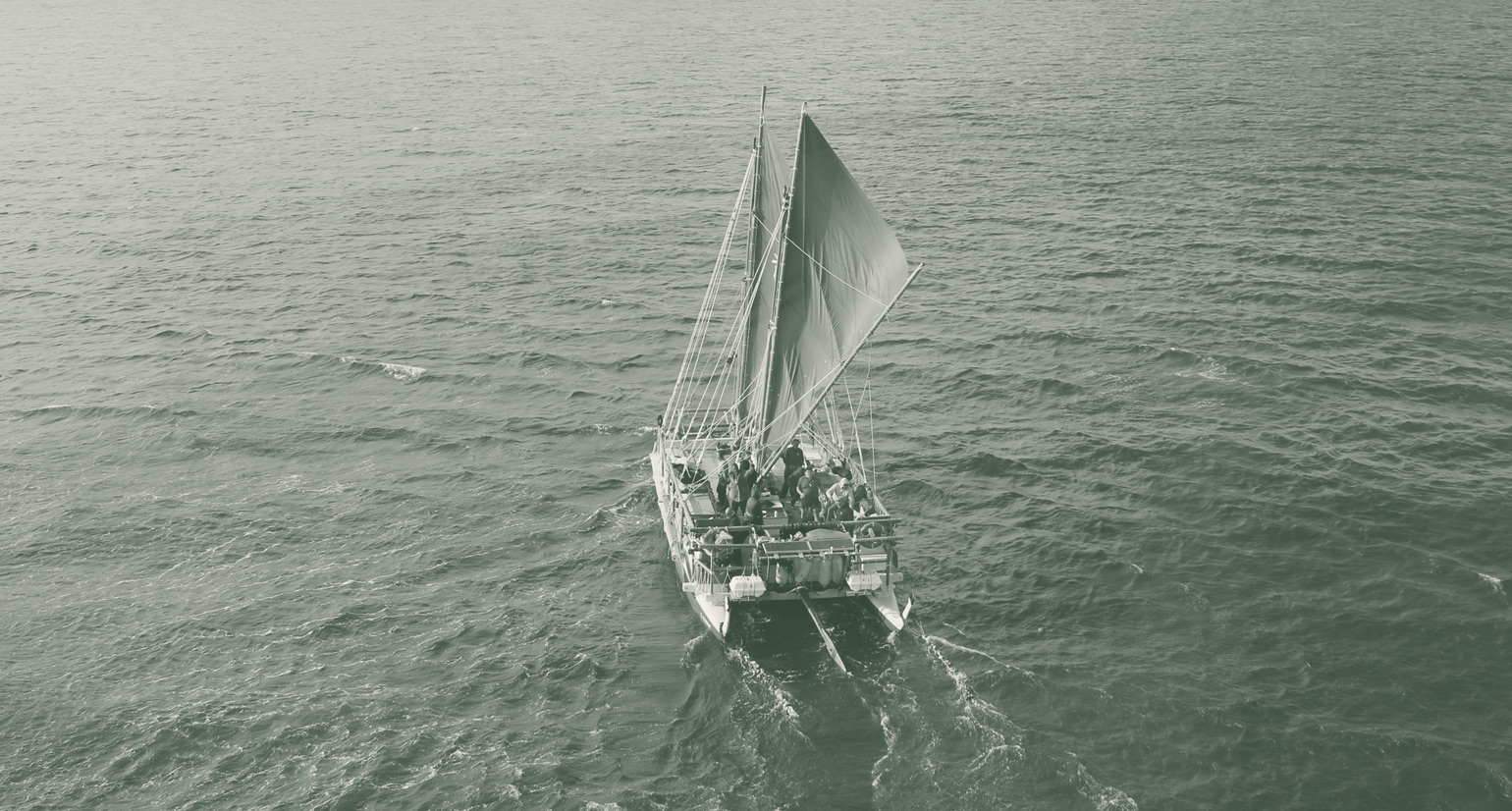
Te purunga literally means ‘The plug’. If you are familiar with a waka, you’ll know that the ‘puru’ is the cork in the hull. If the cork isn’t in place, you’ll be continuously bailing water - or sinking.
This Plan provides a living conceptual logic to be interpreted, challenged and considered through time. It is not comprehensive or exhaustive and should be read in its totality rather than its elemental parts. The various components of the Plan have a focus on galvanising the following:
- An iwi-centred, inclusive development process, grounded in the partnership arising from He Whakaputanga and Te Tiriti o Waitangi.
- The elevation of whānau across all aspects of regional workforce planning and economic development into the future.
- A conceptual and narrative framework bound through whakapapa to people and place.
- A series of high-quality priorities and actions that positively support an enlightened delivery of identity and wellbeing for the region and its communities.
The following points provide a lens through which to consider and align the delivery of the RWP with elements of the unique characteristics and identity of Taitokerau. While each part has been defined to express and identify a bespoke direction, it should be interpreted and nuanced holistically as it is read.
Equity and inclusion
Defining culture
Knowledge and understanding
The value of metaphor
He kōrero pitomata
A historical account
Geographically, Taitokerau was one of the first areas settled by Māori, and subsequently Pākehā, because of its location at the northern-most tip of New Zealand and the advantages presented by its natural resources and temperate climate.
At present, Northland still draws heavily on its pastoral, forestry and primary industry strengths built off its land and water assets.
Historically, the security and permanency of occupation in the North was characterised by regional alliances that worked for the greater good of the whole. This is not to downplay the prominence of hapū identity. Rather, it was common for hapū to continuously transform and develop nascent relationships in accordance with their lived circumstances. Naturally, there were conflicts between hapū that sometimes resulted in the dissolving of allegiances. However, these disputes were not entered into lightly and were – in some instances – settled without resorting to warfare.
The ability to exercise mana and rangatiratanga as Taitokerau hinged on coming together as a collective to make sense of the shifting realities of the time. It is this fundamental premise that gives life to the region’s unique nationhood and reinforces the interplay between freedom and capability. Mana (loosely translated as ‘authority’) regulated our engagements with each other and maintained a sense of balance within communities. This was present at the signing of both He Whakaputanga and Te Tiriti and continues to regulate our relationships today.
Te Toki a Tāpiri Waka Taua
Te Toki-a-Tāpiri, is the oldest surviving waka taua in Aotearoa, made in the 1830s at Iwitea, just north of Wairoa. The tauihu (bow carvings), taurapa (stern post) and rauawa (side strakes) were subsequently carved by Te Waaka Perohuka of the Ngāti Kaipoho hapū of Rongowhakaata. In 1853, Perohuka gifted the waka to Tāmati Waka Nene and his brother Patuone (Ngāpuhi). It then spent time on the Rangaunu Harbour in the care of Nōpera Pana-kareao (Te Rarawa). The waka passed into the guardianship of Paora Tuhaere, (Ngāti Whātua o Ōrākei) before being was confiscated by the New Zealand Government in 1885 and presented to the Auckland Museum where it has remained until today. Te Toki-a-Tāpiri powerfully characterises our trade philosophy and process. It is a symbol of mana, transaction and reciprocity.
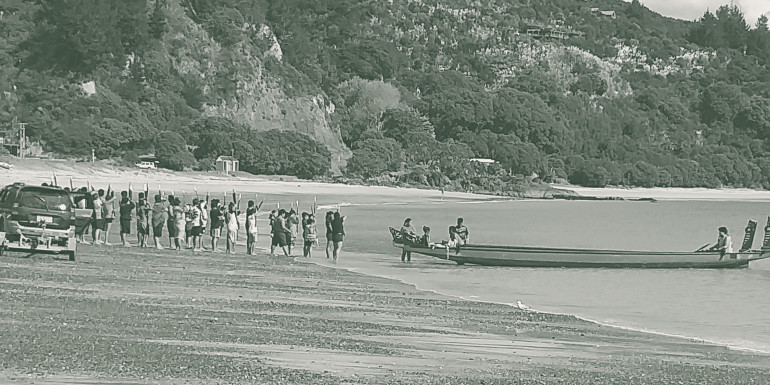
Puna whakaata
While early contact within Taitokerau was, for the most part, agreeable, it was not long until cultural differences of the indigenous and settler cultures collided, arising largely from conflicts over land and differing concepts of authority. The introduction of muskets also had a deadly effect, with numerous battles fought in what are now known as the Musket Wars. Since its signing Te Tiriti has also been at the centre of disputes pertaining to the differences between its English and Māori language versions, its intentions, and how and whether these intentions have been upheld.
The combination of natural assets and rich socio-cultural history are an important source of distinctiveness for Taitokerau.
Maintaining and enhancing this is an important foundation for industry growth. But our industry must grow alongside our wellbeing as whānau, hapū and iwi. We maintain our culture alongside our economic aspirations as a natural process. Waka have been a significant marker of this continuity. At a domestic level we have largely retained an unbroken connection to this aspect of our identity.
Treaty of Waitangi settlements, alongside iwi investment and kaupapa, have and will continue to provide hapū with further opportunities to realise their aspirations for sustainable prosperity and wellbeing for generations to come, as well as for the broader economy.
"It is said Hongi Hika would not bow down to the King of England ... But that misses the point. Hongi was seeking a relationship, a friendship. A relationship of equals. That is the reason for Hongi Hika travelling to England."
— Erima Henare, The Whakaputanga me te Tiriti – The Declaration and the Treaty – Waitangi Tribunal Report, 2014. pg 106
Ngā-toki-mata-whao-rua waka taua
Ngā-toki-mata-whao-rua waka taua was constructed by Northern and Waikato carvers for the centennial of Te Titiri o Waitangi in 1940 through the auspices of Te Puea Hērangi (Waikato). 35.7 metres in length, it is the world’s largest ceremonial waka. It can carry 80 kaihoe and 55 passengers. The lineage of the name relates back to the Ngā- toki-mata-whao-rua waka hourua. It was named to reflect the reshaping of the Matahourua waka bought to Aotearoa by Kupe. The names of the adzes used to reform the waka were Ngā Pakitua and Tauira Ata. It was subsequently captained by Nukutawhiti before travelling back to Aotearoa with theMāmari waka, captained by Ruanui. After 34 years of non-use, Ngā-toki-mata-whao- rua was put back on the water in 1974 and is now a central part of Waitangi commemoration each year. It remains a powerful marker of the iwi/Crown relationship. It was designated Her Majesty’s Ship, making it, on one-hand, a part of her Royal Navy. Ngā-toki-mata-whao-rua is an important demonstration of the centrality of waka to our history and to our philosophy of connection, identity and mana – it is a symbol of partnership premised on the retention of rangatiratanga.
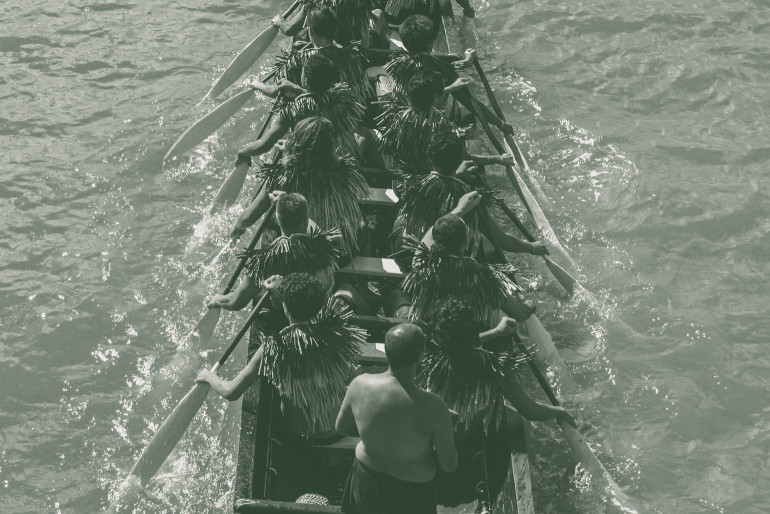
Our history is one of profound continuity within change. We have a distinct opportunity to continue our legacy as a people of first movers. As the region first settled by both the ancestors of Māori and Pākehā, and as a social and politically adaptative and innovative rohe, we are navigating a recalibrated course forward.
Like our histories, waka will guide and maintain our pathways – cosmologically, figuratively, and physically. Each component of the waka is connected harmoniously to form a whole. One of the smallest parts of a waka, the puru typifies this critical aspect. It enables the waka (figuratively and physically) to voyage into the future, embody our lived experiences, and maintain our immutable potential, a potential built on innovation, identity and resilience.
He tohu tūhono, he tohu whiti, e kitea ai ā tātou kōrero, e ēki ai tō tātou pitomata
A marker of connection and transformation, signifying our history, enabling our immutable potential
Te Aurere Waka Hourua
Te Aurere was the first traditional waka hourua (double hulled voyaging canoe) built by Tā Hekenukumai Puhipi (Ngāti Kahu, Te Rarawa). Alongside many circumnavigations of the North Island, her maiden voyage was to Rarotonga in 1992. Since then it has sailed over the Pacific to Hawai’i, Tahiti, Marquesas, New Caledonia, Norfolk and Rapa Nui. Capable of carrying up to 14 crew Te Aurere was formed from two kauri trees from the Herekino State Forest. Te Aurere is 57 foot long and 18 foot wide, and is capable of 12 knots. Te Aurere is a modern-day example of our time-honoured practices. It stands as testimony to the centrality of waka to our identity, and the unique ability of Taitokerau to maintain customary practices alongside our broader aspirations for growth and development.
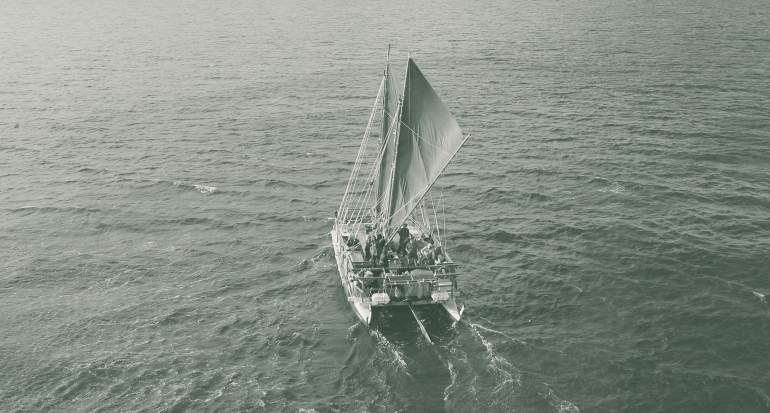
Mana Tuku Iho
“Everything [we do] is towards the theme of cooperation and mutual benefit, because our ancestors committed us to that.”
— Hilda Wilson (talking about Hekenukumai Busby), Heke-nuku-mai-nga-iwi Busby: Not Here by Chance, by Jeff Evans, 2015, Huia Publishers, pg. 67-68
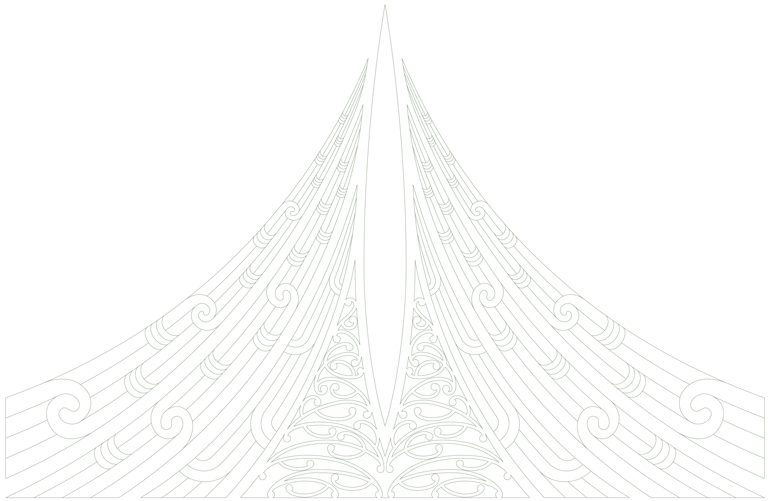
Te Puru
A conceptual framework
The following section sets out a conceptual approach to materialising the Plan, built on the metaphor of the puru.
Drawn from the name given by Pita Tipene to the Taitokerau RSLG - Te Purunga ki Te Raki, the puru while small, is a significant symbol of our waka histories through time.
The concept of the puru enables a simple but dynamic metaphor from which we can consider and bind the various dimensions of this Plan. It allows members of the RSLG to interpret and consider innovative approaches and considerations at a more personal and intuitive level.
Like all metaphors, the concept of the puru allows for ongoing, expansive and multi-layered interpretations.
This Plan establishes a foundation from which the interpretations can continue to be explored, executed and understood.
At a material level, puru are the bung, or stopper, used to seal the hull at the bottom of a waka. As a metaphor, the puru can be extended to represent or symbolise a broad range of meanings including:
- An intervention: including but not limited to He Whakaputanga and Te Tiriti o Waitangi;
- An intent: the placing of the bung signals an intent to journey (kaupapa);
- The physical and metaphysical: Tāne, taiao and mauri;
- Scale: although small it is critical;
- Connection and convergence: demarcating the threshold between Tāne and Tangaroa; and Tangata Whenua and Tauiwi (as examples); and
- Survival and wellbeing: enables seaworthiness and therefore the survival of all on board.
Whakapapa
Forming an ecology
Kitenga/Vision
Ka mau te puru ki te raki, ka mau mārika te puru ki te ao
When the northern economy is confident the world benefits
Iho/Unifying idea
He tohu tūhono, he tohu whiti, e kitea ai ā tātou kōrero, e ēki ai tō tātou pitomata
A marker of connection and transformation, signifying our history, enabling our immutable potential
Ngā pou e toru/The conceptual pillars
1. He Purunga Whakaaro (Signifying our intent)
Rukuhia te kōhao tapu a Tāne, kia ū, kia mau
Fasten tight the sacred outlet of Tāne to achieve our aspirations
2. He Purunga Taketake (Maintaining our connection with the natural world)
Ko tā te puru, he whakaū i te hono ki te taiao
The puru reinforces our connection to the natural world
3. He Purunga Ora (Ensuring our wellbeing)
Ka hē te puru, ka totohu te waka
The puru is functionally and symbolically critical to the kaupapa
Ngā pou rautaki/Strategic pillars
1. He Puru Hononga (A symbol of our relationships and connections)
2. He Puru Mātauranga (The strengthening of our capability and capacity)
3. Te Mana o te Puru (Our authorising environment)
Ngā Wahanga
Implementation
The next section presents implementation measures to expand the conceptual direction of the puru, and align the overarching metaphor with the intent of the RWP.
Wāhanga (elements) are defined to help materialise and give life to the concept and organising ideas. All aspects, including the vision, unifying idea and conceptual pillars should be considered and applied parenthetically to maintain the direction and clarity of the concept.
The wāhanga should be considered physically and metaphysically, materially and intangibly, cognitively and emotionally.

